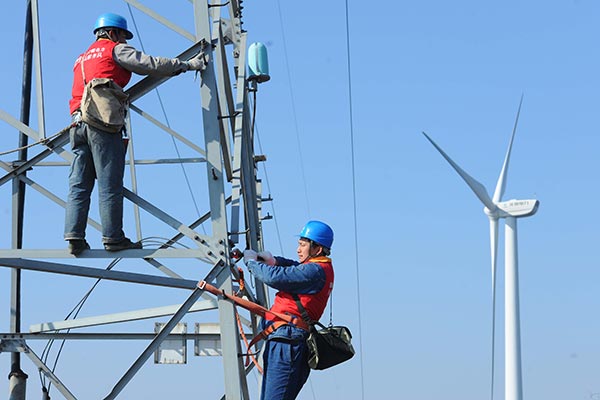 |
|
Workers with the power supply company in Chuzhou, Anhui province, check the transmission network under the State Grid before it is connected with a local wind power farm. [Song Weixing/For China Daily] |
This summer has seen Asia and the Pacific rocked by intense and unstable weather, bringing into even greater focus the need to build resilience against climate change and extreme weather.
Temperatures in the western Indian state of Rajasthan reached record levels in May, peaking at a scorching 51 C. In vast parts of the Pacific, and South and Southeast Asia, rainfall came late, or not at all, and rivers ran dry, wells dried up and lakes turned into dusty plains. Then suddenly, this drought turned to floods, affecting large areas of Bangladesh, Bhutan, China, India, Nepal and Pakistan.
As one of the world's most climate vulnerable regions and a growing emitter of greenhouse gases in its own right, accounting for about 40 percent of the total, Asia and the Pacific has a leading role to play in tackling climate change. But to achieve this Asia and the Pacific must fulfill three essential considerations.
First, countries must now deliver on the promises agreed on at last year's Paris climate conference. Their Intended Nationally Determined Contributions must be turned into solid climate investment plans that promote innovative technologies to advance renewable energy and energy efficiency, and sustainable urban development.
But INDCs go beyond promoting low-carbon growth. Many countries have articulated their adaptation needs, including more resilient infrastructure and climate-smart agriculture. They will need support from development partners to build resilience to future climate impacts.
Second, countries must firmly couple climate action with policy and structural reforms. A good example of such reforms is China's ongoing structural transformation from energy-intensive manufacturing to services, which will reduce China's industrial and manufacturing overcapacity and help it to peak its carbon dioxide emissions by 2030. And India has launched an ambitious solar energy initiative, including plans to build up 100 gigawatts in solar power generation capacity by 2022. Such reforms will help countries build the economic foundations for low-carbon growth.
Third, countries need robust financing streams. Toward this end, the Asian Development Bank will double its climate financing to $6 billion by 2020. Since public finance will be able to supply only a fraction of the funds needed by countries, it is important that patterns of investment-principally in the private sector-shift and scale up accordingly. The ADB recently raised $1.3 billion using green bonds to help finance climate change mitigation and adaptation projects. It has also backed the first certified climate bond in Asia, issued by a private company earlier this year for a geothermal project in the Philippines.
The Global Green Growth Institute is helping countries mobilize the resources needed to implement green growth policies and deliver climate-friendly results. In 2015, GGGI's in-country work in Colombia, Ethiopia, India and Indonesia helped mobilize investments worth $131 million.
But international support should not end with finance. Countries also need help implementing INDCs so that these financial resources can be used effectively and transparently. Building up capacity to identify and budget for climate investments and to roll out climate-smart regulatory policies will be just as crucial as the finance itself. In this respect, climate change actions must be viewed as integral to the wider pursuit of poverty reduction and contribute to the achievement of the UN Sustainable Development Goals.
The challenges are formidable, but the urgency of climate change requires strong political will and even more concerted international cooperation. With broad participation by governments, the private sector, development partners such as the ADB and GGGI, civil society, and other stakeholders, Asia and the Pacific could spearhead a new low-carbon and climate resilient future for the global good.
Takehiko Nakao is the president of Asian Development Bank and Yvo de Boer is director-general of the Global Green Growth Institute. GGGI is hosting the Global Green Growth Week in Jeju, the Republic of Korea on Sept 5-9, 2016, which will bring together the climate change community to seek ways to move toward a green finance action agenda for 2017.